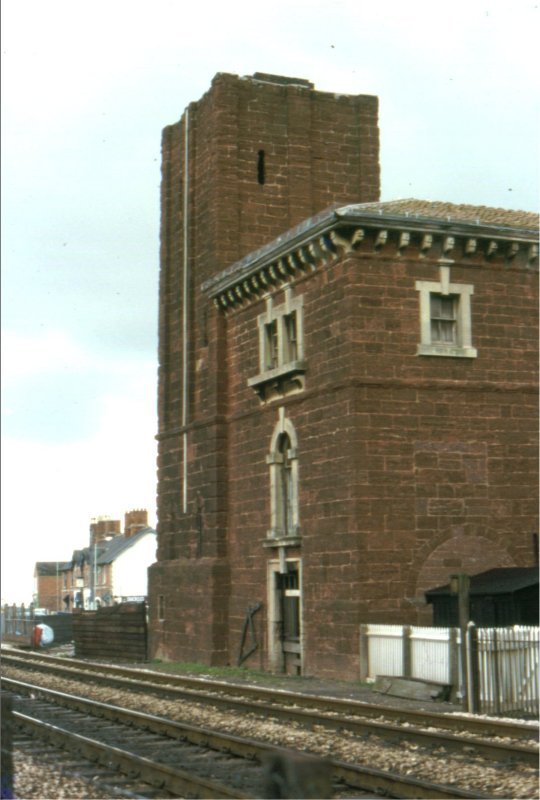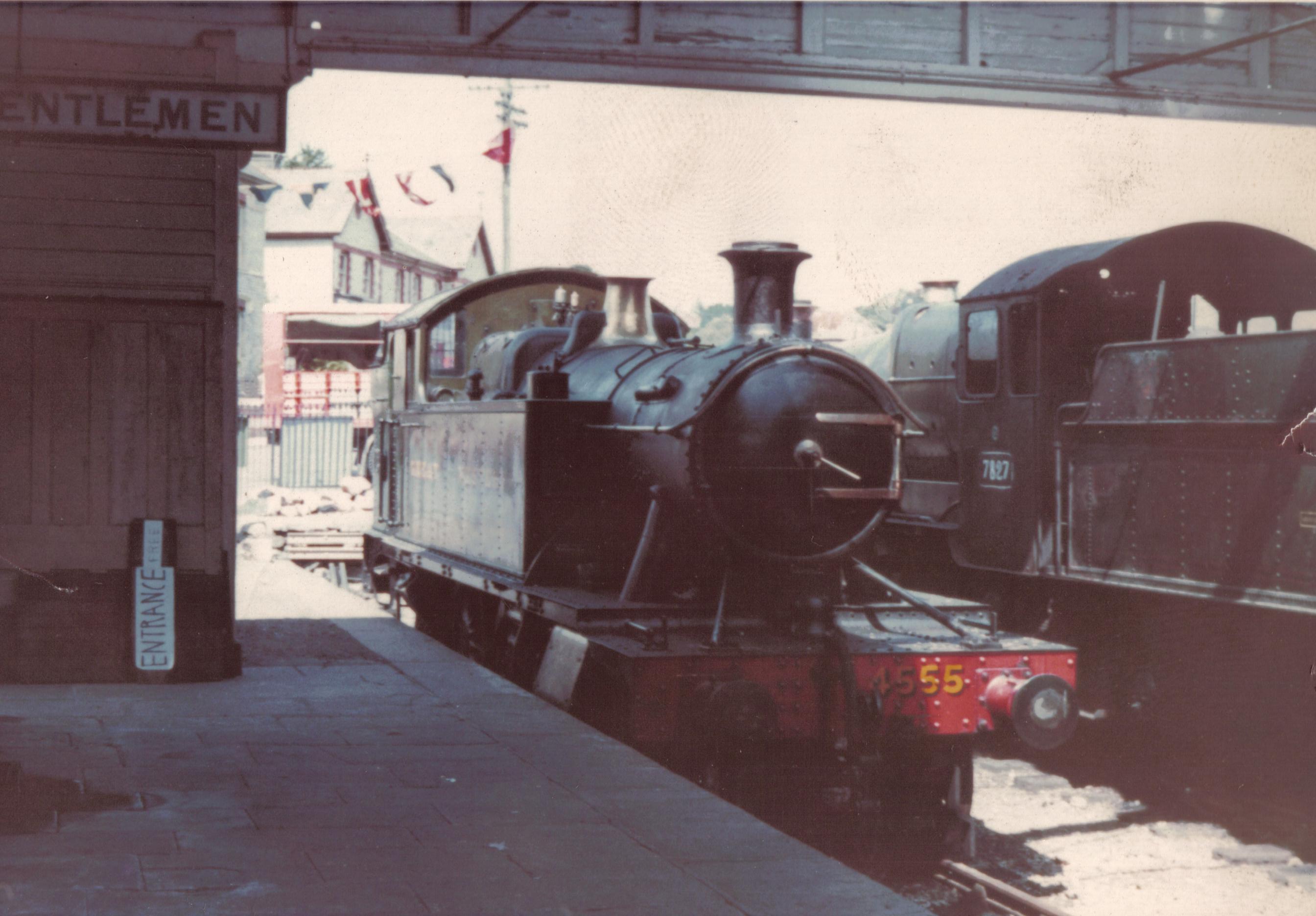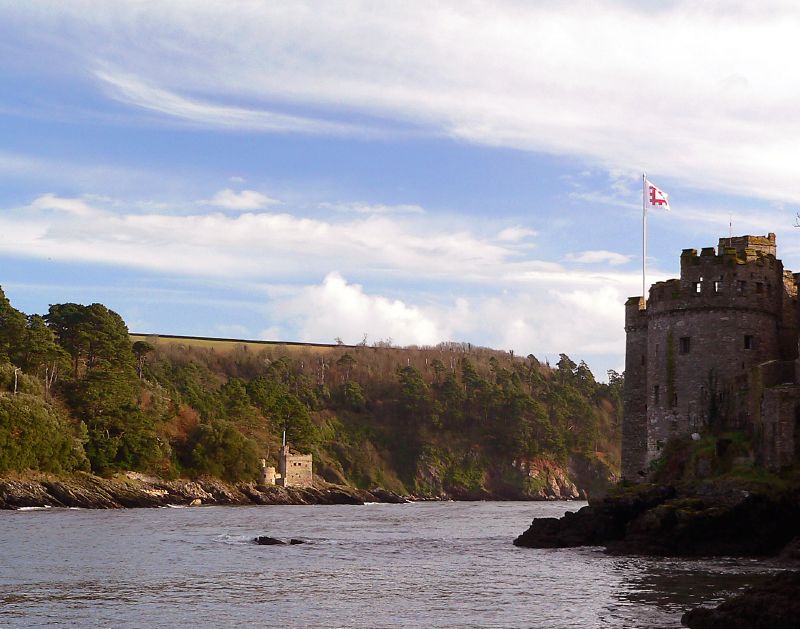|
Totnes Railway Station
Totnes railway station serves the town of Totnes in Devon, England. It was opened by the South Devon Railway Company in 1847. Situated on the Exeter to Plymouth Line, it is located down the line from via . History Totnes railway station was built by the South Devon Railway Company and opened on 20 July 1847 when trains started to run on the line from Newton, as Newton Abbot was known at the time. It was a terminus until 5 May 1848 when trains started to run through to Plymouth, initially using a temporary terminus at Laira. The line was intended to be operated by atmospheric power and an engine house to provide power was built behind the eastbound platform, although it was never brought into use. The two platform tracks were covered by wooden train sheds, an engine shed was built south of the line beyond the westbound platform, and a goods shed was erected between this platform and the River Dart which the line crossed on a viaduct just to the east of the platforms. Totn ... [...More Info...] [...Related Items...] OR: [Wikipedia] [Google] [Baidu] |
Totnes
Totnes ( or ) is a market town and civil parish at the head of the estuary of the River Dart in Devon, England, within the South Devon Area of Outstanding Natural Beauty. It is about west of Paignton, about west-southwest of Torquay and about east-northeast of Plymouth. It is the administrative centre of the South Hams District Council. Totnes has a long recorded history, dating back to 907, when its first castle was built. By the twelfth century it was already an important market town, and its former wealth and importance may be seen from the number of merchants' houses built in the sixteenth and seventeenth centuries. Today, the town has a sizeable alternative and New Age community, known as a place where one can live a Bohemianism, bohemian lifestyle, though has in recent times also gained a reputation as being a hotspot for Conspiracy theory, conspiracy theorists within the UK. The 2021 United Kingdom census, 2021 census recorded a population of 9,214, a 14% increase ... [...More Info...] [...Related Items...] OR: [Wikipedia] [Google] [Baidu] |
South Devon Railway Engine Houses
The South Devon Railway engine houses were built in Devon, England, to power the Atmospheric railway, atmospheric trains on the South Devon Railway Company, South Devon Railway between Exeter St Davids railway station, Exeter St Davids and Plymouth Millbay railway stations. They contained boilers that provided the power to pumps that created the partial vacuum to move the trains. Three of them still stand largely intact alongside the line. History The South Devon Railway was built by Isambard Kingdom Brunel who proposed moving the trains by atmospheric power. Brunel and other engineers travelled to Dalkey in Ireland in 1843 to view such a system undergoing tests on the Dublin and Kingstown Railway. There, Brunel's engineer of locomotives for the GWR, Daniel Gooch, calculated that conventional locomotives could work the proposed line at lower cost, but Brunel's concerns about the heavy grades led him to try the system regardless. The South Devon Railway directors agreed on 28 Au ... [...More Info...] [...Related Items...] OR: [Wikipedia] [Google] [Baidu] |
World War II
World War II or the Second World War (1 September 1939 – 2 September 1945) was a World war, global conflict between two coalitions: the Allies of World War II, Allies and the Axis powers. World War II by country, Nearly all of the world's countries participated, with many nations mobilising all resources in pursuit of total war. Tanks in World War II, Tanks and Air warfare of World War II, aircraft played major roles, enabling the strategic bombing of cities and delivery of the Atomic bombings of Hiroshima and Nagasaki, first and only nuclear weapons ever used in war. World War II is the List of wars by death toll, deadliest conflict in history, causing World War II casualties, the death of 70 to 85 million people, more than half of whom were civilians. Millions died in genocides, including the Holocaust, and by massacres, starvation, and disease. After the Allied victory, Allied-occupied Germany, Germany, Allied-occupied Austria, Austria, Occupation of Japan, Japan, a ... [...More Info...] [...Related Items...] OR: [Wikipedia] [Google] [Baidu] |
Turntable (railroad)
A railway turntable or wheelhouse is a device for turning railway rolling stock, usually locomotives, to face a different direction. It is especially used in areas where economic considerations or a lack of sufficient space have served to weigh against the construction of a turnaround wye. Railways needed a way to turn steam locomotives around for return journeys, as their controls were often not configured for extended periods of running in reverse; also many locomotives had a lower top speed in reverse. Most diesel locomotives, however, can be operated in either direction, and are considered to have "front ends" and "rear ends" (often determined by reference to the location of the crew cab). When a diesel locomotive is operated as a single unit, the railway company often prefers, or requires, that it be run "front end" first. When operated as part of a multiple unit locomotive consist, the locomotives can be arranged so that the consist can be operated "front end first" no ... [...More Info...] [...Related Items...] OR: [Wikipedia] [Google] [Baidu] |
Standard Gauge
A standard-gauge railway is a railway with a track gauge of . The standard gauge is also called Stephenson gauge (after George Stephenson), international gauge, UIC gauge, uniform gauge, normal gauge in Europe, and SGR in East Africa. It is the most widely used track gauge around the world, with about 55% of the lines in the world using it. All high-speed rail lines use standard gauge except High-speed rail in Russia, those in Russia, High-speed rail in Finland, Finland, High-speed rail in Uzbekistan, Uzbekistan, and some line sections in High-speed rail in Spain, Spain. The distance between the inside edges of the heads of the rails is defined to be 1,435 mm except in the United States, Canada, and on some heritage British lines, where it is defined in Imperial and US customary measurement systems, U.S. customary/Imperial units, British Imperial units as exactly "four feet eight and one half inches", which is equivalent to 1,435.1mm. History As railways developed and expa ... [...More Info...] [...Related Items...] OR: [Wikipedia] [Google] [Baidu] |
Broad Gauge
A broad-gauge railway is a railway with a track gauge (the distance between the rails) broader than the used by standard-gauge railways. Broad gauge of , more known as Russian gauge, is the dominant track gauge in former Soviet Union countries (CIS states, Baltic states, Rail transport in Georgia (country), Georgia, Ukraine) and Rail transport in Mongolia, Mongolia. Broad gauge of , commonly known as five foot gauge, is mainly used in Rail transport in Finland, Finland. Broad gauge of , commonly known as Irish gauge, is the dominant track gauge in Ireland, the Australian state of Rail transport in Victoria, Victoria and Railways in Adelaide, Adelaide in South Australia and Rail transport in Brazil, passenger trains of Brazil. Broad gauge of , commonly known as Iberian gauge, is the dominant track gauge in Spain and Portugal. Broad gauge of , commonly known as Indian gauge, is the dominant track gauge in Indian Railways, India, Pakistan Railways, Pakistan, Bangladesh, Sri Lanka ... [...More Info...] [...Related Items...] OR: [Wikipedia] [Google] [Baidu] |
Consolidation (business)
In business, consolidation or amalgamation is the merger and acquisition of many smaller companies into a few much larger ones. In the context of financial accounting, ''consolidation'' refers to the aggregation of financial statements of a group company as consolidated financial statements. The taxation term of consolidation refers to the treatment of a corporate group, group of companies and other entities as one entity for tax purposes. Under the Halsbury's Laws of England, ''amalgamation'' is defined as "a blending together of two or more undertakings into one undertaking, the shareholders of each blending company, becoming, substantially, the shareholders of the blended undertakings. There may be amalgamations, either by transfer of two or more undertakings to a new company or the transfer of one or more companies to an existing company". Overview Consolidation is the practice, in business, of legally combining two or more organizations into a single new one. Upon consolidati ... [...More Info...] [...Related Items...] OR: [Wikipedia] [Google] [Baidu] |
Ashburton Railway Station
Ashburton railway station is a closed railway station situated in the town of Ashburton in Devon, England. It was the terminus of a branch line from Totnes. History Ashburton station, along with the rest of the branch from Totnes, was opened by the Buckfastleigh, Totnes and South Devon Railway on 1 May 1872. The railway was amalgamated into the Great Western Railway in 1897 and this in turn was nationalised into British Railways on 1 January 1948. The station closed to passengers in November 1958 although goods traffic on the line continued until 7 September 1962. The station was briefly re-opened by the Dart Valley Railway, a heritage railway, on 5 April 1969 following which occasional works trains operated but the station was closed finally in 1971 when the track bed between Ashburton and Buckfastleigh was needed for improvements to the A38 road. The South Devon Railway, a successor to the Dart Valley Railway, still operates the remainder of the branch between Totnes ... [...More Info...] [...Related Items...] OR: [Wikipedia] [Google] [Baidu] |
Buckfastleigh, Totnes And South Devon Railway
The Buckfastleigh, Totnes and South Devon Railway built the broad gauge railway line from Totnes to Buckfastleigh and Ashburton in Devon, England. History In the first decades of the nineteenth century, Buckfastleigh and Ashburton were important towns in the region. Ashburton was an important stannary and woollen town, while Buckfastleigh had established woollen mills as well as other manufacturing industries. Both towns were on the coaching road from Plymouth to Exeter, and this transport link was important to their success. When railways in the area began to be proposed, a number of alternative routes between Plymouth and Exeter were put forward, and a line through Buckfastleigh and Ashburton was considered. However, the line actually adopted was the South Devon Railway (SDR) which followed a more southerly course through Teignmouth, Newton Abbot and Totnes. This line opened in 1847,The SDR opened to Totnes in 1847; it had opened the previous year to Newton, later called Newt ... [...More Info...] [...Related Items...] OR: [Wikipedia] [Google] [Baidu] |
Viaduct
A viaduct is a specific type of bridge that consists of a series of arches, piers or columns supporting a long elevated railway or road. Typically a viaduct connects two points of roughly equal elevation, allowing direct overpass across a wide valley, road, river, or other low-lying terrain features and obstacles. The term ''viaduct'' is derived from the Latin ''via'' meaning "road", and ''ducere'' meaning "to lead". It is a 19th-century derivation from an analogy with ancient Roman aqueducts. Like the Roman aqueducts, many early viaducts comprised a series of arches of roughly equal length. Over land The longest viaduct in antiquity may have been the Pont Serme which crossed wide marshes in southern France. At its longest point, it measured 2,679 meters with a width of 22 meters. Viaducts are commonly used in many cities that are railroad hubs, such as Chicago, Birmingham, London and Manchester. These viaducts cross the large railroad yards that are needed for freigh ... [...More Info...] [...Related Items...] OR: [Wikipedia] [Google] [Baidu] |
River Dart
The River Dart is a river in Devon, England, that source (river), rises high on Dartmoor and flows for to the sea at Dartmouth, Devon, Dartmouth. Name Most hydronyms in England derive from the Common Brittonic, Brythonic language (from which the river's subsequent names ultimately derive from an original Celtic languages, Celtic etymology. As the lower stretches of the river are still covered in ancient oak woodlands, it is accepted that the first element derives from , meaning 'oak' (, ). However the second element (evident in the hard consonantal termination of ''Dar-t'') is less certain, with postulated etymologies from / ('sacred place of oak') or / ('oak stream'). The Ravenna Cosmography records a number of Latinisation of names, Latinised names for the area, and may represent corrupted doublets of a ('station') on a river named . Although the name is otherwise unattested for the river, it is an established etymology throughout Britain, found at the River Darent, ... [...More Info...] [...Related Items...] OR: [Wikipedia] [Google] [Baidu] |
Goods Shed
A goods shed is a railway building designed for storing goods before, after, and during loading to and unloading from a train. A typical goods shed will have a track running through it to allow goods wagons to be unloaded under cover, although sometimes they were built alongside a track with possibly just a canopy over the door. There will also be a door to move goods to or from road wagons and vans, this sometimes is parallel to the rail track, or sometimes on the side opposite the rail track. Inside the shed will generally be a platform and sometimes a small crane to allow easier loading and unloading of wagons. Double track Some goods sheds had more than one track. If one were not adjacent to the unloading platform then the method of working the second siding would be to first empty the wagons adjacent to the platform, and then open the doors on their far side to access those on the second track. Planks or portable bridges were normally provided for this purpose. Conve ... [...More Info...] [...Related Items...] OR: [Wikipedia] [Google] [Baidu] |







